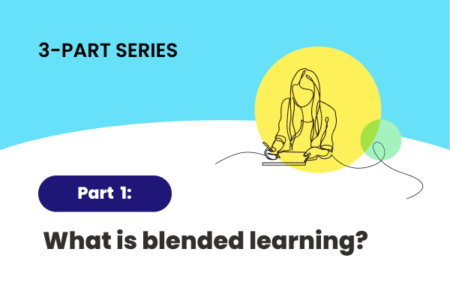In our three-part series, Blending the eLearning Experience with OpenSesame, we’ll provide an overview on blended learning, introduce global publishers who provide blended learning materials, and explore some ways you can blend the learning experience when a course doesn’t contain materials for facilitators.
by Teagan Carlson
There’s ample research in support of blended learning. It has been linked to a host of positive results, including increases in learning outcomes and achievement, course completion, and learner satisfaction. The U.S. Department of Education’s oft-cited report noted students in blended learning classes outperformed those in fully online or fully in-person classes. Unfortunately, one of the biggest challenges in creating a blended learning program is that it isn’t always easy.
Blended Learning Defined
Blended learning is defined as a learning program that combines online and instructor-led training (ILT). This may take many different forms; online could include elearning courses or self-guided research, for instance. The instructor-led training could be in a traditional classroom setting or a virtual tutoring session.
Blended Learning Models
There are a variety of ways to format a blended learning program, especially as meeting remotely becomes easier and more accepted, but schools and organizations typically use one of three.
-
Flipped instruction
The most common is called flipped instruction or the flipped classroom. This model is called flipped because it’s the opposite of what we think of when we think of traditional classroom instruction. In the traditional K-12 or higher ed learning environment, the student receives an in-class lecture and then practices the lectured content independently as homework.
With flipped instruction, the learner takes an elearning course, doing the learning upfront and independently, and then that learning is reinforced later through activities and discussions guided by a facilitator. The facilitation can be one-on-one, but I recommend group facilitation to maximize the benefits of social learning.
-
Flex learning
In a flex learning model, learners take elearning courses independently, and during this learning experience, a facilitator is available to answer questions and assist, either in-person or virtually.
-
Self-blended learning
And finally, “self-blended” or personalized learning usually starts as a traditional learning model, with the learner receiving instruction in a traditional, classroom-like setting. Then, they supplement this instruction with online, self-directed learning (SDL) where they conduct research or select and take their own elearning courses, for instance.
What Makes Blended Learning So Effective
Blended learning works because it combines all the benefits of elearning and facilitated or instructor-led training. Review just some of the benefits in the following chart:
Benefits
| eLearning | ILT and Facilitated Instruction |
|
|
For more information on blended learning, see the resources below. To get a better idea of how you can incorporate a blended learning strategy into your talent development programs using OpenSesame’s innovative tools and features, or for general inquiries, connect with one of our experts for a personalized, guided demo.
About Teagan Carlson
Teagan is an eLearning Development Specialist with OpenSesame. She has a Master’s degree in Educational Psychology and has worked in education for over fifteen years.
Teagan presented this information to the OpenSesame Customer Feedback Group in June with Senior Curation Specialist Molly Broder. The Customer Feedback Group will be hosting a follow-up meeting in September, where a panel of OpenSesame customers will share how they incorporate blending learning into their L&D programs






